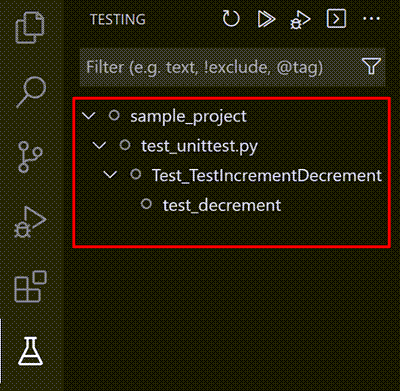pytest
References
- 🔗 Documentation - Pytest
- 🔗 拾遺 - Python 測試入門 - 開始使用 PyTest
- 🔗 CSDN - pytest.ini
- 🔗 IT 邦 - Python 與自動化測試的敲門磚
- 🔗 知乎 - Pytest fixture 及 conftest 详解
- 🔗 Pytest With Eric - Ultimate Guide To Pytest Markers And Good Test Management
- 🔗 Pytest With Eric - What Is pytest.ini And How To Save Time Using Pytest Config
- 🎞️ ArjanCodes - How To Write Unit Tests For Existing Python Code // Part 1 of 2
- 🎞️ ArjanCodes - How To Write Unit Tests For Existing Python Code // Part 2 of 2
Note
| 📘 NOTE |
|---|
1. 放置在 test / tests 目錄內 |
2. 模組名稱為 test_*.py |
| ☢️ WARNING |
|---|
1. 測試目錄與被測試目錄皆要有 __init__.py |
| 2. 測試目錄路徑不可有不合法名稱 (比如有中括號 [] 的名稱,會被誤當成 .ini 的 section)。 否則會產生錯誤 OSError: Starting path not found。 |
3. 測試目錄路徑若有任一目錄改過名稱,請務必清除測試目錄底下的__pycache__。否則會產生錯誤 OSError: Starting path not found。 |
4. TestClass 的第一個引數都要是 self,就如同在寫一般 class 一樣。 |
CLI
-
選項
--markers: 查看所有已註冊的 markers--fixtures: 查看所有已註冊的 fixtures-h: 參數說明 (help)-v: 詳細結果 (verbose)-q: 簡潔結果 (quiet)-s: 允許 stdout / stderr 印出 (會打亂 pytest 測試結果輸出格式)
-
測試範圍
-
全部測試
-
針對某個子目錄進行測試
-
針對某個模組進行測試
-
針對某個模組中某個函式進行測試
-
針對某個模組中某個類別進行測試
-
針對某個模組中某個類別的某個方法進行測試
-
-
CLI 測試結果
./PASSED: 代表一個通過的 test cases/SKIPPED: 代表一個跳過的 test casex/XFAILED: 代表一個已預期失敗 (等待修復) 的 test caseF/FAILED: 代表一個失敗的 test case[80%]: 代表的是總完成進度 (百分比)
Config
.vscode/settings.json
pytest.ini
| 📗 TIP |
|---|
如果你使用 pyproject.toml,只要將以下設定都置於 [tool.pytest.ini_options] 即可 |
Global
conftest.py
-
說明
- 可創建 fixture,有效範圍:同目錄內所有 test case 可見,無須 import。
- 自訂命令列選項
-
example
-
tests/conftest.py -
tests/test_something.py
-
Usage
斷言驗證
錯誤驗證 raises
| 🚨 CAUTION |
|---|
| 每個 with 述句只能驗證一個錯誤 |
資源初始化與釋放 setup / teardown
- context management
缺點 : 無法接受引數
夾具 fixture
-
decorator kwargs
scope: 變數生命週期的作用域,預設為 "function"
(在每個 test case 裡都會重新 create 一遍)name: 變數調用名稱,預設就是函式的名稱autouse: 是否在每個 test case 中自動使用,預設為 False
(根據 scope 而定,如果 scope="function",那不需傳遞引數就會自動調用)params: 參數化測試,應給定 list[dict[str, Any]]
-
必要性
Q : 為何使用 fixture,而不使用 global variable 就好?
global variable 寫起來不是更簡單嗎?A : 請看下例,如果 fixture
test_data變成一般的 global variable,
就會造成test_data通過第一個 test case 後,反而無法通過之後的 test case。
很明顯,test_data需要在每個 test case 執行前重新 create 一遍。
fixture(scope="function")因而派上用場。 -
參數
autousescope="function" 的 autouse 會讓模組內的 test case 自動使用 clear_tables。
如果有非常多的 test cases,就不須每個都套上 decorator。
內建夾具 : 猴子補丁 monkeypatch
- 輸入 mock
- 覆蓋環境變數
內建夾具 : 擷取輸出流 capsys
-
輸出流
-
錯誤流
內建夾具 : 擷取日誌 caplog
內建夾具 : 暫時路徑 tmp_path
| 📘 NOTE |
|---|
在 Windows 中,這些暫時目錄或檔案會放在 %APPDATA%/Local/Temp/pytest-of-user 中 |
內建夾具 : 快取 cache
標記 mark.?
| 🚨 CAUTION |
|---|
要先在 pytest.ini 註冊,方可使用自訂標記 |
-
標記自訂 marker
-
只選擇有 mark.database 的 test case 進行測試
內建標記 : 條件跳過案例 mark.skip / mark.skipif
-
decorator kwargs
condition: 條件為真時跳過該 test casereason: 跳過測試的原因 (在 verbose 模式會印出來)
-
example
內建標記 : 已預期失敗案例 mark.xfail
-
decorator kwargs
reason: 跳過測試的原因 (在 verbose 模式會印出來)
-
example
內建標記 : 參數化測試 mark.parametrize
| 🚨 CAUTION |
|---|
| 可搭配 fixture 使用,但它一定要裝飾在最靠近函式的地方 |
-
decorator kwargs
argnames: 參數名稱argvalues: 參數值 (可以有多組值)ids: 每個 test case 的名稱
-
example
-
ids
內建標記 : 使用夾具 mark.usefixtures
基本上功能與 fixture 傳遞引數寫法無異。
但通常用在欲使用 fixture 達成 context management 的場合,
而非使用它的回傳值做用途的場合。
上下文順序 : 由左至右、由下至上
-
context management : fixture + yield
-
為什麼不用
setup/teardown就好?不像 setup / teardown 函數無法傳遞引數,
使用 fixture 做 context management 的好處是可以傳遞引數。
如下,傳遞的引數為test_session
pytest-cov
插件:覆蓋率測試
References
Note
| 🚨 CAUTION |
|---|
| 預設的覆蓋率計算方法是行數覆蓋 (line coverage) |
CLI
-
選項
--cov=<path>: 只根據指定路徑,進行覆蓋率測試 (會產生一個.coverage檔)--cov-report=<type>:<path>: 產生覆蓋率測試報告 (<type>指定格式,如html/xml;<path>指定報告輸出目錄)--cov-config=<path>: 覆蓋率測試的 config (預設是.coveragerc)--cov-branch: 將覆蓋率計算方法設為分支覆蓋 (branch coverage)
-
快速打開覆蓋率測試 HTML 報告 (Windows)
Config
.coveragerc
Usage
內建夾具 : 不計入覆蓋率 no_cover
無效化某個 test case 所造成的覆蓋
pytest-mock
插件:提供 Stub、Mock、Spy 等功能,擴充自標準庫的 unittest.mock
References
Usage
內建夾具 : Mocker mocker
-
mocekr.Mock: 建立一個 mock 物件return_value: 被呼叫時的回傳值。spec- 給定 class,此 mock 物件只能使用給定 class 存在的屬性或方法,否則引發
AttributeError。 - 給定 list,此 mock 物件只能使用給定 list 中的屬性或方法,否則引發
AttributeError。
- 給定 class,此 mock 物件只能使用給定 class 存在的屬性或方法,否則引發
side_effect- 給定 function,此 mock 物件被呼叫時,由此函數代為執行。
- 給定 exception,將引發錯誤
- 給定 iterable,將其中每個值作為每次呼叫 mock 物件的不同回傳值。
-
mocekr.MagicMock: 建立一個 mock 物件 (已事先設定好 magic method),此類別繼承自Mock -
mocker.patch: 全域補丁一個函式或變數 -
mocker.patch.object: 針對某物件補丁一個方法或屬性 -
mocker.patch.multiple: 針對某物件補丁多個方法或屬性 -
mocker.patch.dict: 特別針對字典補丁 (採用 update,常用於環境變數) -
mocker.stop: 停止一個 mock 物件的功能 -
mocker.stopall: 停止所有 mock 物件的功能 -
mocker.spy: spy 功能 (僅做監控不做替代,MUT 的原功能仍會執行) -
mocker.stub: stub 功能 (常用於頂替 callback) -
mocker.mock_open: 模擬builtins.open的行為 (讓我們在測試時,不須去讀寫檔案) -
mock 物件
- 每種
mocker.?都會回傳一個 mock 物件 - 你可以藉由這個 mock 物件,進行監控、停止功能等操作。
- 方法
method description mock.assert_called()確保 mock 物件至少被呼叫一次 mock.assert_called_once()確保 mock 物件只被呼叫一次 mock.assert_called_with(*args, **kwargs)確保 mock 物件最後一次呼叫的參數符合 mock.assert_called_once_with(*args, **kwargs)確保 mock 物件只被呼叫一次,且參數完全匹配 mock.assert_any_call(*args, **kwargs)確保 mock 物件至少有一次以該參數呼叫 mock.assert_has_calls([call(*args, **kwargs), call(*args, **kwargs), ...], any_order=False)確保 mock 物件有一組特定的呼叫序列,可選擇順序是否無關。記得 from unittest.mock import call!mock.assert_not_called()確保 mock 物件從未被呼叫過 mock.assert_call_count(n)確保 mock 物件被呼叫 n次
- 每種
Note
dependency injection
non-dependency injection
-
case 1 : MUT 使用到了外部依賴
🚨 CAUTION 當 SUT 採用 from A import B使用外部依賴時,mocker.patch的路徑應填上"SUT_path.B",
否則會導致 SUT 沒有使用到你設定好的 mock 物件! -
case 2 : MUT 呼叫了 SUT 內的另一個方法


